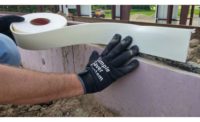Following the mantra of “learning by the sea,” the new Sullivan’s Island Elementary School in South Carolina is only a stone’s throw from the Atlantic Ocean. Perched above a beautiful beach, the 74,000-square-foot school is built on stilts, which raise the classrooms to nearly treetop level. Windows that open to the sea encourage exploration and inspiration inside the school, where instructors teach academic skills and environmental responsibility.
Given its beach-front location, the selection of Petersen’s PAC-CLAD aluminum roof and wall panels was an obvious choice to counter the corrosive environment and protect the school from frequent, punishing storms and occasional earthquakes. The opening of the new building marks the return of the school to its island namesake after being moved off-island for four years because of safety concerns.
Architectural design for the project was provided by Cummings & McCrady Architects in Charleston. The island primarily is residential with only a few commercial buildings. Architect Jerry English, principal, said, “The thrust of the design was to make sure we created a structure that was in keeping with the personality of the island. The design incorporated many different levels and planes to break up the mass and assure that we were sympathetic to the community and neighboring residences. And the Petersen ribbed metal roof definitely added a nice character element. Its constant exposure to the wind and beach necessitated the .040 heavy gauge aluminum.”
The design team at Cummings & McCrady held a series of community meetings to gather design input and keep the public informed. “We had a lot of meetings!” English noted. “And we incorporated many of the ideas that emerged. For example, the inverted metal roof panels that slope inward atop the signature entrance tower offer a bit of design refinement to help the building relate to the island as community members wanted.”
More than 92,000 square-feet of PAC-CLAD .040 aluminum in several different profiles and applications was specified, including 51,000 square-feet of 18-inch Tite-Loc Plus panels finished in Champagne for the roof, and 18,000 square-feet of 12-inch Flush Panels finished in Almond and Champagne for wall applications. In addition, 22,000 square-feet of flat sheet was utilized.
Panel testing for the high wind uplifts was a significant factor in the selection of Petersen products, said Dave Landis, architectural/technical sales manager. “We used Miami-Dade NOA engineering information to show the architect that the .040 aluminum panels would exceed the 130 mph wind load requirements for the job.”
Petersen used a mobile roll-former to fabricate panels more than 80 feet long at the jobsite. Some panels reached 110 feet. All other panels were manufactured at Petersen’s Acworth, Ga., plant.
English recommends that architects rely on the guidance and expertise available from manufacturers of various architectural products. “If you’re going to do something that’s a little bit out of the ordinary, contact the right people and bring their input into the design. The results will be better for everybody,” English said. “For example, in working with our Petersen technical sales manager Dave Landis, we worked through the design so that we would not have cross-seams.”
Installation of the panels was performed by Keating Roofing & Sheet Metal Co. in Charleston.
Long-recognized for its metal standing seam roofing products, Petersen also offers metal wall panels including exposed fastener panels, flush panels, composite panels, fascia and coping systems, plus column covers. All provide the well-known Petersen quality and are available in PAC-CLAD full 70 percent PVDF finish in more than 40 colors on steel and aluminum. Most colors meet LEED, Energy Star and Cool Roof Rating Council certification requirements.
For more information on the complete line of Petersen metal products, call 800-PAC-CLAD or visit pac-clad.com.






